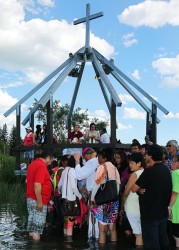Article Origin
Volume
Issue
Year
The Fort McMurray First Nation is requesting the raw data collected from one of Alberta’s largest oil spills in its traditional territory.
“There’s concern about the environmental impact. (Nexen Energy) has given us access to the site, we’ve been looking at it, but lately, we’ve requested the raw testing data so we can look over it ourselves,” said Councillor Byron Bates. That data has not been forthcoming. “We’re considering sending our own team of testers in to do the testing.”
A contractor discovered the spill on July 15 at Nexen Energy’s Long Lake oilsands project. The pipeline was shut in immediately. About five million litres of bitumen, sand and produced water covered a 16,000-square metre area. Most of the leak was within the pipeline right of way and was contained on the site because of remnants of berms that were created for construction.
“The leak has been stabilized, the pipeline shut down, there is control in place,” said Ron Bailey, Nexen’s senior vice-president of Canadian operations, in a news conference two days after the incident. “We’re looking to minimize the environmental damage and working on site clean-up.”
The failsafe systems on the line designed to detect the spill did not work. Company officials say the line may have been leaking for up to two weeks. No other visual leaks have been found. The double layered pipeline was put in the ground in 2014 and started operating in the fourth quarter last year.
“We are deeply concerned with this and we…sincerely apologize for the impact that this has caused. We will take every step that we see as reasonable and as the regulators help us decide what to do to respond to this,” said Bailey.
Bates lives in one of the 100 residences located 10 km from the spill.
“I smelled it once outside my place. Friday morning (July 17) I was on the roof to fix my satellite because we were watching the news and I caught a whiff of it,” he said.
Bates says it took five to six hours for his First Nation to be notified via email by the Alberta Emergency Management Agency of the spill. Nexen contacted the Alberta Energy Regulator first as is required.
“A spill that size, they should have been on the phone to our First Nations right away,” said Bates. “Who knows how the air quality is going to affect us?”
Nexen corporate communications manager Diane Kossman says the company notified Fort McMurray First Nation, Chipewyan Prairie Dene First Nation, leadership in the community of Anzac, as well as two parties with trap lines that run across the land in close proximity to the release, “within hours of the discovery of the spill.”
The spill area, which is on traditional land, also impacts Heart Lake First Nation.
Ryan Bartlett, public affairs spokesman with AER, says AER has been in contact with all three First Nations as well as several Métis communities in the area.
In an email response, Kossman said, “We’ve been taking a very proactive, collaborative approach with our closest neighbours. They have been very generous with their time, sharing their traditional knowledge, familiarity and understanding of the land and environment as they support us with clean-up efforts.”
Bates says he is pleased with the daily emails and communication that is running between the First Nation and the company and the First Nation has a representative on site regularly.
Energy Minister Marg McCuaig-Boyd and Environment and Parks Minister Shannon Phillips accompanied Bates on his second visit to the site on July 24. Nexen and AER officials were also in attendance.
“Spills like this are unacceptable,” said McCuaig-Boyd in a statement issued after the site visitation. “We all want to know that when an incident like this happens, not only is it contained and cleaned up, but every possible effort is made to find out what went wrong and fix it; prevent it from happening again here or anywhere else in Alberta.”
Immediately following notification of the spill, the AER issued a four-point environmental protection order to Nexen, which included containing the spill; notifying impacted parties; developing a remediation plan; and publishing daily reports on the Nexen website.
Bartlett says Nexen has not offered a time frame as to when clean-up of the site is expected to be completed.
“More important than having a time frame, they want to make sure it’s done correctly and that’s what we want as well,” said Bartlett. “They’re a significant amount of time (away) from operating any line in that area.”
Photo Caption: Thousands flock to annual pilgrimage. Father Sylvain Lavoie stands among the people during the Blessing of the Lake on July 19. The weather was perfect for the annual Lac Ste. Anne pilgrimage, which attracted thousands of people from July 18-23.
- 1916 views

